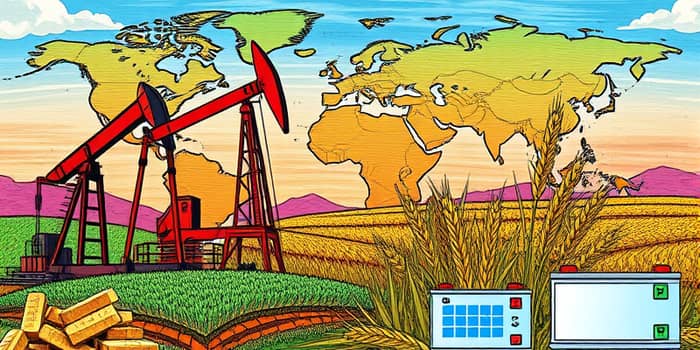
In today’s interconnected markets, commodities serve as the building blocks of global growth—and they are in constant motion. From energy and metals to agriculture and emerging critical minerals, understanding the forces at play is essential for investors, policymakers, and businesses alike.
After a sharp 12% drop in 2024, overall commodity prices are poised to decline another 5% in 2025, reaching a six-year low in historic price trends. A slowing global economy underpins this outlook, while upside surprises remain possible if growth accelerates or if extreme weather disrupts supply.
Trade disputes and sanctions, especially between major powers, continue to reshape export flows. National strategies to secure critical minerals and strengthen supply chains are prompting new entrants and adding volatility across markets. Meanwhile, inflationary pressures have driven gold and other precious metals into focus as traditional inflation hedges for cautious investors.
Global oil faces a delicate balance: OPEC+ must choose between preserving market share or supporting prices by cutting output. With U.S. production near record highs and demand from China subdued, analysts predict WTI crude could dip below sustainable drilling levels if growth remains lackluster.
Natural gas prices sit at multi-year lows due to ample storage and rising U.S. LNG capacity. By 2027, exports are expected to surge, meeting European demand when pipeline deals expire. Industrial users are increasingly switching from coal to gas, while data centers fuel another wave of consumption.
Base metals markets are under pressure. Steel overcapacity—driven by China’s weak demand and global capacity build-outs—pressures prices. Copper and aluminum look muted through 2025, but green energy investment and potential Fed rate cuts could spark a recovery in 2026.
In precious metals, gold and silver remain in a bull phase. With central banks increasing purchases and investors seeking safe havens, these metals are beneficiaries of dovish monetary policy. Uranium stands out with forecasts targeting $100 per pound by late 2026, supported by nuclear energy expansion and supply constraints in key mining regions.
Demand for critical minerals—lithium, cobalt, nickel—continues its meteoric rise amid the global drive toward electrification. This trend presents high-growth opportunities for emerging market producers, but also introduces geopolitical risks and funding challenges in Latin America and Africa.
Agricultural markets are characterized by historically high soybean and maize stocks, putting downward pressure on prices. Wheat stocks are tighter but still adequate, while rice prices may retreat after India eases export curbs. Fertilizer cost increases, however, could establish a price floor for certain grains.
Climate variability threatens crop yields and food security, particularly in vulnerable regions. To manage risk, producers and traders are innovating with prepayment schemes and barter arrangements, ensuring liquidity and smoothing supply chain financing in high-risk markets.
New commodity classes like biofuels, carbon credits, and renewable certificates are attracting attention. EU Allowances (EUAs) could climb to €95 per ton by end-2025—a 20% premium over current levels—on tighter emissions trading system balances and speculative flows.
Energy traders are diversifying into metals and softs, while digital tools—such as blockchain-based letters of credit—promise to streamline metals trading. Equity partnerships and innovative capital solutions are also reshaping financing in agriculture.
As global growth dynamics evolve, market participants must remain vigilant. By embracing innovative financing and supply diversification, they can turn volatility into opportunity. Above all, a nuanced understanding of these intertwined forces will be the key to thriving in a world of constant commodity flux and shifting risks.
References





